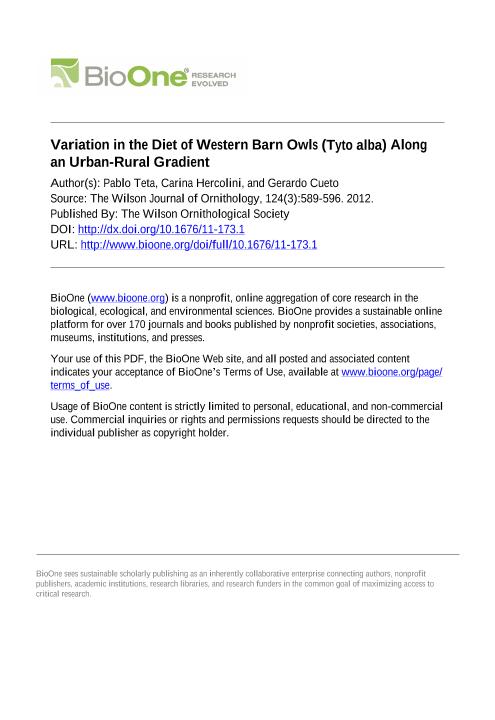Mostrar el registro sencillo del ítem
dc.contributor.author
Teta, Pablo Vicente

dc.contributor.author
Hercolini, Carina Belén

dc.contributor.author
Cueto, Gerardo Ruben

dc.date.available
2019-01-16T22:00:44Z
dc.date.issued
2012-09
dc.identifier.citation
Teta, Pablo Vicente; Hercolini, Carina Belén; Cueto, Gerardo Ruben; Variation in the diet of Western Barn Owls (Tyto alba) along an urban-rural gradient; Wilson Ornithological Society; Wilson Journal of Ornithology; 124; 3; 9-2012; 589-596
dc.identifier.issn
1559-4491
dc.identifier.uri
http://hdl.handle.net/11336/68182
dc.description.abstract
We studied geographic variation in the diet of Western Barn Owls (Tyto alba) along a urban-rural gradient in central-eastern Argentina and identified 5,231 prey items. Mammals were present in all samples, whereas birds and amphibians were present in 79.1 and 50.0% of the samples, respectively. There were significant differences in vertebrate assemblages consumed by Barn Owls at the opposite extremes of the gradient. Native sigmodontine rodents comprised 85.8 of the total prey items, especially towards periurban and rural areas. Exotic murid rodents were the main prey item in urban sites, while birds increased in frequency in urban and periurban areas. Food niche breadth and standardized food niche breadth values were higher at intermediate levels of urbanization (= periurban). This 'periurban peak' in species diversity is a relatively well-known pattern, previously reported for taxa such as birds, lizards, bumblebees, and butterflies among others. The trophic habits of Barn Owls along this gradient were mostly similar to those reported in other studies in southern South America, where the main prey items were native rodents and food niche breadth values (measured at the level of Orders) were low. Western Barn Owls in our study maintained specialization as a micromammal predator.
dc.format
application/pdf
dc.language.iso
eng
dc.publisher
Wilson Ornithological Society

dc.rights
info:eu-repo/semantics/openAccess
dc.rights.uri
https://creativecommons.org/licenses/by-nc-sa/2.5/ar/
dc.subject
Diet
dc.subject
Tyto Alba
dc.subject
Urban
dc.subject
Gradient
dc.subject.classification
Otras Ciencias Biológicas

dc.subject.classification
Ciencias Biológicas

dc.subject.classification
CIENCIAS NATURALES Y EXACTAS

dc.title
Variation in the diet of Western Barn Owls (Tyto alba) along an urban-rural gradient
dc.type
info:eu-repo/semantics/article
dc.type
info:ar-repo/semantics/artículo
dc.type
info:eu-repo/semantics/publishedVersion
dc.date.updated
2019-01-16T18:19:09Z
dc.identifier.eissn
1938-5447
dc.journal.volume
124
dc.journal.number
3
dc.journal.pagination
589-596
dc.journal.pais
Estados Unidos

dc.description.fil
Fil: Teta, Pablo Vicente. Consejo Nacional de Investigaciones Científicas y Técnicas. Centro Nacional Patagónico; Argentina
dc.description.fil
Fil: Hercolini, Carina Belén. Universidad de Buenos Aires. Facultad de Ciencias Exactas y Naturales. Departamento de Ecología, Genética y Evolución; Argentina
dc.description.fil
Fil: Cueto, Gerardo Ruben. Consejo Nacional de Investigaciones Científicas y Técnicas. Oficina de Coordinación Administrativa Ciudad Universitaria. Instituto de Ecología, Genética y Evolución de Buenos Aires. Universidad de Buenos Aires. Facultad de Ciencias Exactas y Naturales. Instituto de Ecología, Genética y Evolución de Buenos Aires; Argentina
dc.journal.title
Wilson Journal of Ornithology

dc.relation.alternativeid
info:eu-repo/semantics/altIdentifier/url/https://bioone.org/journals/the-wilson-journal-of-ornithology/volume-124/issue-3/11-173.1/Variation-in-the-Diet-of-Western-Barn-Owls-span-classgenus/10.1676/11-173.1.short
dc.relation.alternativeid
info:eu-repo/semantics/altIdentifier/doi/https://doi.org/10.1676/11-173.1
Archivos asociados
